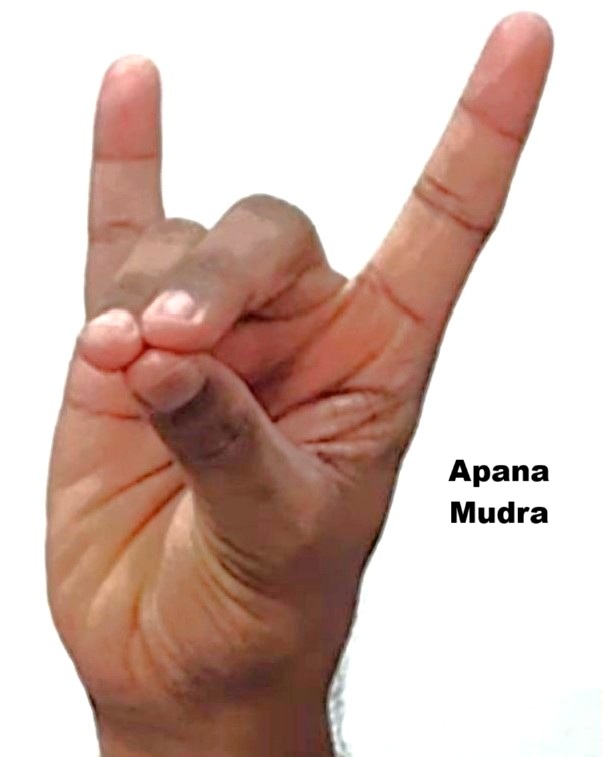Mrigi Mudra
Introduction
Mrigi Mudra is a hand gesture used primarily in Pranayama (breath control practices), especially in Nadi Shodhana (alternate nostril breathing). It is a simple yet powerful mudra where specific fingers are used to alternately close and open the nostrils, helping regulate breath and balance energy flow in the body.
This mudra is essential in yogic breathing practices as it directly influences the flow of prana (life force) through the Ida and Pingala nadis, leading to balance of the left and right brain hemispheres.
Meaning
Mrigi = deer (in Sanskrit)
Mudra = seal, gesture
The hand gesture is named “deer gesture” because the positioning of the fingers resembles a deer’s face and antlers. Symbolically, it represents alertness, calmness, and balance of nature’s rhythm, just like a deer in the forest.
How to Perform Practice
Sit comfortably in Sukhasana, Padmasana, or any meditative seated posture with the spine upright.
Use your right hand to make a ‘paw’ with your fingers .
Bring your index finger and middle finger down to the middle of the palm,
Deer seal (mrigi mudra) uses an alternative breathing technique in which air is inhaled through one nostril and inhaled through another.
Place your thumb against your right nostril as you inhale through the left nostril.
Then using your thumb and ring finger keep both nasal cavities closed. The thumb should close the right nostril, while the ring finger should pin the left nostril.
Raise your thumb and allow the air to exit your right nostril.
Repeat this entire sequence twice, once using the right nostril in step 4, and once using the left nostril in step 4.
Repeat this set of three breaths at least two or three times.
Benefits
Physical Benefits
Improves lung capacity and respiratory efficiency.
Enhances oxygenation and circulation.
Strengthens the nervous and endocrine systems.
Mental & Emotional Benefits
Balances left (Ida – lunar) and right (Pingala – solar) energy channels.
Reduces stress, anxiety, and restlessness.
Improves focus, clarity, and emotional balance.
Spiritual Benefits
Prepares for deep meditation by harmonizing prana.
Awakens Sushumna nadi, facilitating higher states of consciousness.
Purifies nadis, an essential step in Kundalini awakening practices.
Contraindications
Avoid during cold, nasal congestion, or sinus infections.
People with serious respiratory disorders (asthma in acute attack, COPD flare-ups) should consult a yoga therapist before practicing.
Should not be practiced immediately after heavy meals.
Avoid excessive strain while holding breath (for beginners).
Anatomy & Physiology
Engages the nasal passages, lungs, and diaphragm.
Enhances oxygen–carbon dioxide exchange.
Stimulates the autonomic nervous system, balancing sympathetic (fight/flight) and parasympathetic (rest/digest) functions.
Improves vagal tone, lowering stress response.
Kinesiology
Requires fine motor coordination of the hand, especially thumb and ring finger control.
Stabilizes shoulder, arm, and hand muscles while maintaining the mudra.
Works synergistically with diaphragmatic and intercostal muscles during breathing regulation.
Neurology
Stimulates the olfactory and trigeminal nerves through controlled nostril closure.
Influences limbic system, reducing stress and promoting calm.
Balances left and right brain hemispheres, enhancing concentration and memory.
Duration of Mudra
Beginners: 5 minutes of practice during Pranayama.
Intermediate: 10–15 minutes daily.
Advanced: 20–30 minutes integrated into extended Nadi Shodhana or Pranayama sessions.
Best practiced early morning (Brahma Muhurta) or evening on an empty stomach.
Counter Mudra
Chin Mudra → to stabilize and ground prana after pranayama.
Jnana Mudra → to enhance meditative awareness after balancing breath.
Prana Mudra → to recharge after extended breath control.
Conclusion
Mrigi Mudra is a fundamental hand gesture in yogic breathing practices, essential for Nadi Shodhana and Anulom Vilom Pranayama. It harmonizes the flow of prana, balances body–mind energy, and prepares the practitioner for meditation and spiritual growth. As a practical tool, it enhances respiratory health, calms the mind, and deepens awareness, making it a vital part of Pranayama practice in Yoga.
FAQ
Q1: Can Mrigi Mudra be practiced without Pranayama?
Yes, but its primary purpose is for breath regulation in Pranayama.
Q2: Why use the right hand only?
Traditionally, the right hand is used to regulate breath while the left hand rests in a grounding mudra.
Q3: Can children practice it?
Yes, under guidance, especially with simple alternate nostril breathing.
Q4: What if my fingers feel tired?
Relax the arm on a cushion or practice shorter rounds.
Q5: Is it necessary to fold index and middle fingers?
Yes, in classical tradition, but some schools allow resting them on the forehead.
References
Swami Satyananda Saraswati – Asana, Pranayama, Mudra, Bandha
B.K.S. Iyengar – Light on Pranayama
Dr. Hiroshi Motoyama – Science and the Evolution of Consciousness
Gertrud Hirschi – Mudras: Yoga in Your Hands
Bihar School of Yoga Publications
